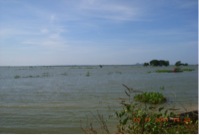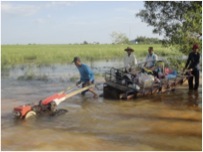As the floodwaters in Cambodia recede, the work of recovery and reconstruction begins. Fr Greg Priyadi SJ, Director of Jesuit Service Cambodia, reflects on the damage caused of by worst floods the country has experienced in years and the tough times faced by the people who have lost their homes, their harvest and their livelihoods.
This is supposed to be a happy time for most people in Cambodia. The farmers are waiting for harvest which usually begins in November. People flock to the cities, especially Phnom Penh, to enjoy water festival, which in this year is from November 10 to 12.
The Cambodian Water Festival, in Khmer language Bon Om Touk, takes place once a year, on the full moon of the Buddhist month of Kadeuk (usually in November). It celebrates a major natural occurrence: the reversing flow of the Tonle Sap river from Tonle Sap lake to the Mekong River. In dry season, the Tonle Sap lake empties into the Mekong River. However, when the rainy season arrives in the end of May, the volume of water in the Mekong rises, reversing the flow to dump water into the lake, increasing its size five to ten-fold. When the rainy season ends in November, the volume of water in Mekong drops once more, causing the current to reverse again, emptying the excess waters of Tonle Sap lake back into the Mekong.
This unique natural phenomenon is celebrated in Cambodia with three days of festivals, river parades, boat races, fireworks and general merriment.
 But this year is different. The floods have scattered the hope of the people. The damage they caused eclipsed that of typhoon Ketsana in 2009, The rainwater at the beginning of the planting season promised good harvest for this year. But the floods that inundated the rice paddy for more than one and a half months destroyed the crop.
But this year is different. The floods have scattered the hope of the people. The damage they caused eclipsed that of typhoon Ketsana in 2009, The rainwater at the beginning of the planting season promised good harvest for this year. But the floods that inundated the rice paddy for more than one and a half months destroyed the crop.
This year, the water festival is celebrated without boat racing, the landmark event of the feast. On October 13, 2011, Prime Minister Hun Sen announced that the government had decided to cancel boat races due to the worst flooding the country has seen in over a decade that devastated the countryside. The water level of Tonle Sap river, the venue of the boat racing, is still very high, making the race risky for participants. The flooding in the provinces has brought the people much suffering and government has to spent million of US dollars on assistance to the people.
 At least 15 provinces of the 29 provinces in the country suffered from the floods. Those provinces are along the Mekong and Tonle Sap rivers, or along the border with Thailand like Batambang and Banteay Meachey provinces. The figures by the National Committee for Disaster Management showed that 173,063 families were affected by the flooding. Of these, more than 50,000 families were evacuated. At the height of the flooding, more than 400,000 hectares of rice paddy were inundated. It is estimated that 230,000 hectares of paddy have been destroyed. The flood also forced 1,360 schools to close, mostly primary schools. The death toll reached at least 141. More than 1,110 livestock died. The damage of agriculture and infrastructure could reach the total amount of US$520 million.
At least 15 provinces of the 29 provinces in the country suffered from the floods. Those provinces are along the Mekong and Tonle Sap rivers, or along the border with Thailand like Batambang and Banteay Meachey provinces. The figures by the National Committee for Disaster Management showed that 173,063 families were affected by the flooding. Of these, more than 50,000 families were evacuated. At the height of the flooding, more than 400,000 hectares of rice paddy were inundated. It is estimated that 230,000 hectares of paddy have been destroyed. The flood also forced 1,360 schools to close, mostly primary schools. The death toll reached at least 141. More than 1,110 livestock died. The damage of agriculture and infrastructure could reach the total amount of US$520 million.
Mr Hun Sen also announced that the government would be putting US$100 million from its 2010 and 2011 reserves toward relief efforts and rehabilitation. China donated US$7, 833,000 to help the country cope with the devastation. Japan donated US$325,000. The government, Cambodia Red Cross, NGOs, Churches, and other institutions have joined efforts to give aid- relief.
The floodwaters have receded and the majority of flood evacuees have moved home. As of last week, 1,113 schools have been reopened. But other problems arise. Poor living conditions are a perfect incubator for disease. There is a big risk of diarrhoea and other illnesses. Malaria and dengue fever are also a big concern.
 Roads were damaged. Many crocodiles escaped from farms and pose a danger to the people. A child died after being bitten by a crocodile when he swam in the lake. There was a story of a crocodile creeping up the stairs of a flooded house to steal the livestock. Farmers encountered crocodiles in inundated rice fields.
Roads were damaged. Many crocodiles escaped from farms and pose a danger to the people. A child died after being bitten by a crocodile when he swam in the lake. There was a story of a crocodile creeping up the stairs of a flooded house to steal the livestock. Farmers encountered crocodiles in inundated rice fields.
The effects of the floods will be long. With infrastructure damaged and houses destroyed, reconstruction will take time. Given the fact that the rice crops are ruined and the harvest has failed, there is a real need of emergency relief in the near future.
To see more pictures of the extent of the floods in Cambodia, click here.
Related story – Amid the devastation of repeated floods.

